Constraints to smallholders participation in Cassava value ... - aaacp
Constraints to smallholders participation in Cassava value ... - aaacp
Constraints to smallholders participation in Cassava value ... - aaacp
Create successful ePaper yourself
Turn your PDF publications into a flip-book with our unique Google optimized e-Paper software.
1 Introduction and overview<strong>Cassava</strong> is a staple food <strong>in</strong> Zambia second only <strong>in</strong> importance <strong>to</strong> maize. An estimated thirty percen<strong>to</strong>f Zambians - about 4 million people - consume cassava as part of their staple diet. The majority ofthese cassava consumers live <strong>in</strong> the northern part of the country cover<strong>in</strong>g Northern, Luapula,Northwestern and Western Prov<strong>in</strong>ces and parts of the Copperbelt which are also the ma<strong>in</strong> grow<strong>in</strong>gand consum<strong>in</strong>g areas of the crop, and have been so s<strong>in</strong>ce the <strong>in</strong>troduction of cassava <strong>to</strong> Africa by theearly Portuguese travellers and colonists. Production is almost entirely by smallholder farmerswhose average cultivated area is less than one hectare. Increas<strong>in</strong>gly, however, production andconsumption of cassava is tak<strong>in</strong>g place <strong>in</strong> the southern half of the country where the ZambianGovernment and NGOs have promoted cassava <strong>in</strong> response <strong>to</strong> recurrent cycles of drought whichhave led <strong>to</strong> failure of maize, the ma<strong>in</strong> staple crop <strong>in</strong> the region. Demand for cassava for both humanand <strong>in</strong>dustrial consumption has also grown <strong>in</strong> the urban and <strong>in</strong>dustrial centres of Lusaka andCopperbelt prov<strong>in</strong>ces. <strong>Cassava</strong> production has steadily <strong>in</strong>creased from 139,000 Mt <strong>in</strong> 1965 <strong>to</strong>1,160,853 <strong>in</strong> 2007/8.The Government of Zambia (GoZ) have been <strong>in</strong>volved with research on varietal improvement, andNGOs have been <strong>in</strong>strumental <strong>in</strong> seed multiplication and distribution: PAM, World Vision, Care, PlanInternational, FAO, WFP, and DFID. Dissem<strong>in</strong>ation of improved varieties (IVs) has been undertaken <strong>in</strong>traditional areas where there has been varietal switch<strong>in</strong>g, and <strong>to</strong> the non-cassava drought-pronesouthern and eastern areas. Other <strong>in</strong>terventions <strong>to</strong> promote cassava production that have takenplace are capacity build<strong>in</strong>g <strong>in</strong> small-scale process<strong>in</strong>g of cassava <strong>in</strong><strong>to</strong> flour and chips and for sale <strong>to</strong>the mill<strong>in</strong>g <strong>in</strong>dustry and some food and lives<strong>to</strong>ck feed firms.Some farmers have adopted the IVs and some have not, whilst still others have reverted from IVs <strong>to</strong>traditional varieties (TVs). IVs are better adapted <strong>to</strong> respond <strong>to</strong> <strong>value</strong> cha<strong>in</strong> opportunities as they areearly matur<strong>in</strong>g and high yield<strong>in</strong>g. TVs on the other hand are low yield<strong>in</strong>g and late matur<strong>in</strong>g but offerthe advantage of longer underground s<strong>to</strong>rability. There is currently limited knowledge of who isgrow<strong>in</strong>g the improved varieties and little understand<strong>in</strong>g of the reason<strong>in</strong>g beh<strong>in</strong>d farmers’ choices.This report concerns research <strong>in</strong> Chongwe District, Lusaka Prov<strong>in</strong>ce <strong>to</strong> explore these issues andcreate new knowledge about the propensity of Zambian smallholder farmers <strong>to</strong> engage <strong>in</strong> thedevelopment of the cassava sec<strong>to</strong>r. While household responses <strong>to</strong> production <strong>in</strong>terventions and<strong>in</strong>centives will vary with household circumstances, public sec<strong>to</strong>r <strong>in</strong>terventions and private sec<strong>to</strong>r<strong>in</strong>itiatives have <strong>to</strong> take <strong>in</strong><strong>to</strong> account the marked regional differentiation of both production andutilisation/consumption. The levels of human and natural assets for cassava production arefavourable <strong>in</strong> the north and west, but remoteness from major markets imposes <strong>in</strong>formation and<strong>in</strong>frastructure requirements. Elsewhere, while available data are limited, the development of newproduction capacity <strong>to</strong> meet potential demand will require <strong>in</strong>vestment <strong>in</strong> human capacity build<strong>in</strong>g:multiplication and distribution of plant<strong>in</strong>g materials, agricultural extension and capacity build<strong>in</strong>g.The results of this explora<strong>to</strong>ry work suggest that non-growers of cassava resembled growers <strong>in</strong> thesocio-economic fundamentals of household structure, gender, and assets such as provision ofelectricity, potable water, irrigation and access <strong>to</strong> credit. It is likely that unobservable characteristicssuch as personal attitudes and aptitudes of rural people, rather than more measurable socio-4
















